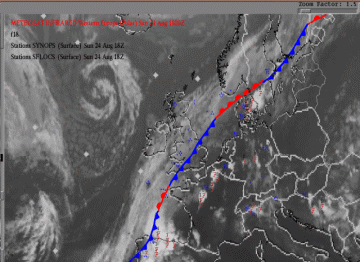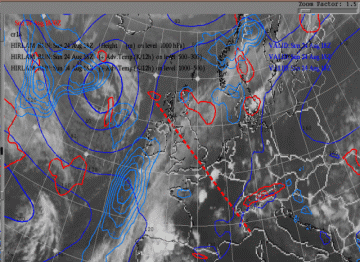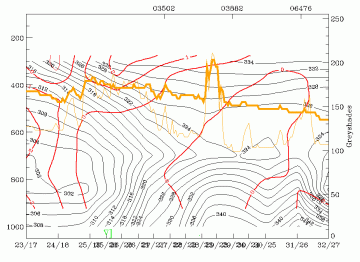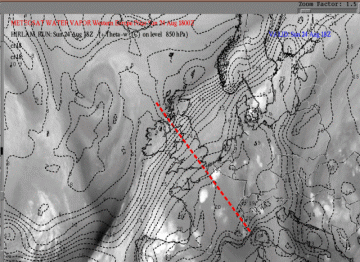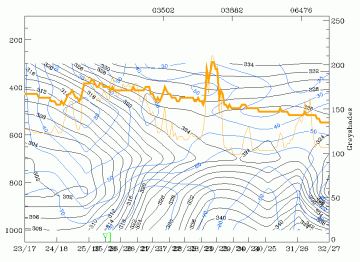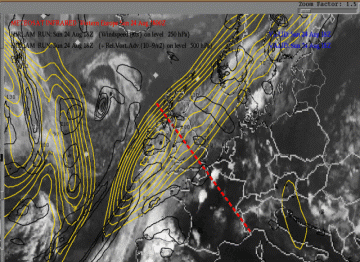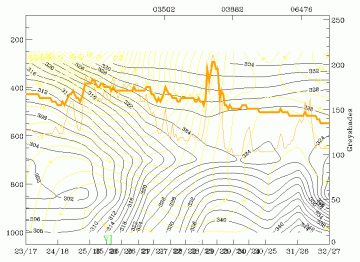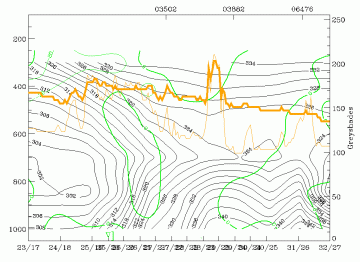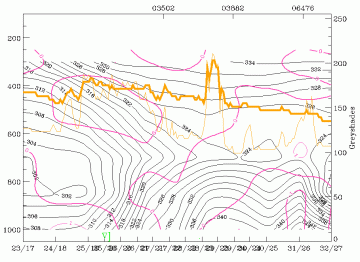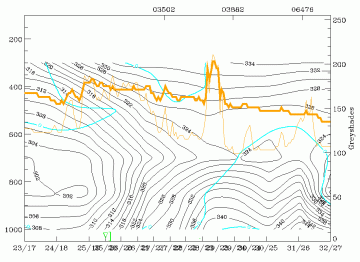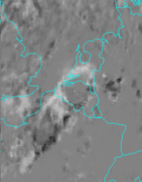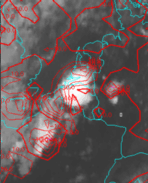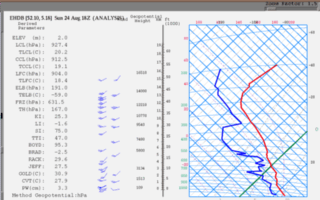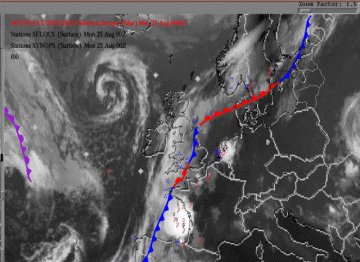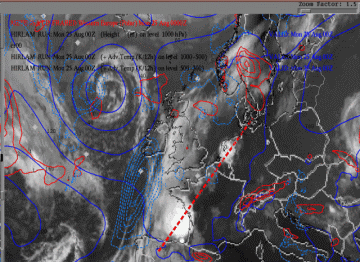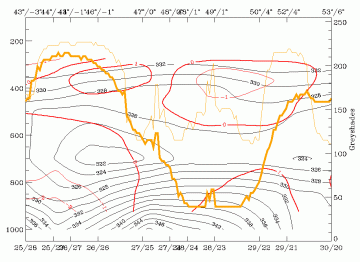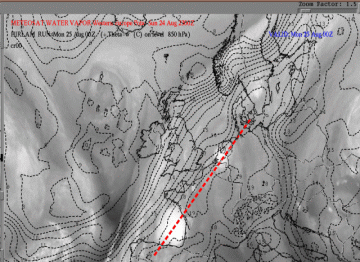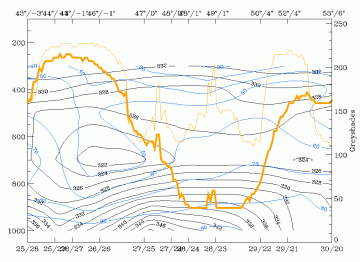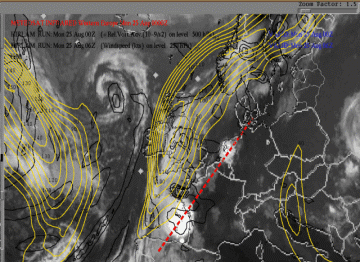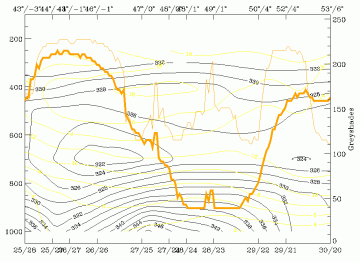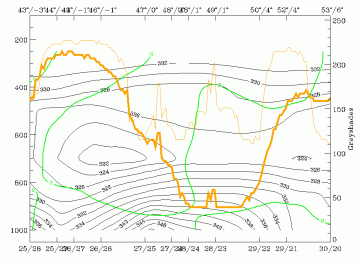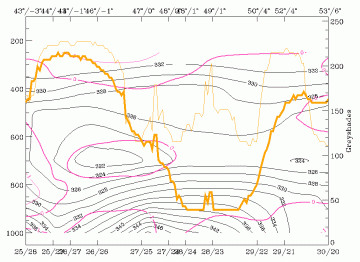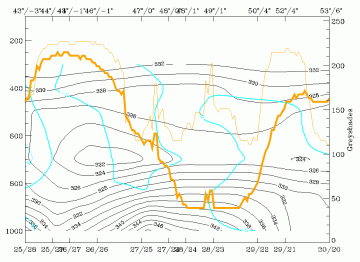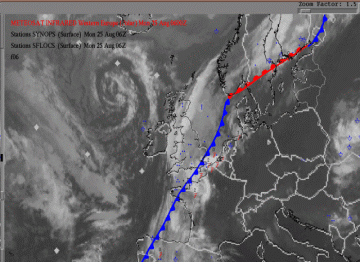Table of Contents
Diagnosis 24 August 18.00 UTC
|
24 August 1997/18.00 UTC - Meteosat IR image; weather events (blue: WW code, red: SFLOCS)
|
|
The satellite image contains the cloud bands of a polar Cold Front (compare Conceptual Models: Cold Front ). The front is quasi-stationary and therefore shows a wavy pattern. The cloud features to be investigated are the two northerly cloud clusters over France and the extended cluster over Spain and the Bay of Biscay. In all the mentioned cloud clusters thunderstorm activity was reported. At 18.00 UTC both clusters over France (48N/01E and 50N/03E) were moving in a north to north-easterly direction.
For the diagnosis of the physical state of the conceptual model Mesoscale Convective System a couple of key parameter and useful key parameters combinations are available which were chosen with respect to the conceptual model (for more information see Conceptual Models: Cumulonimbus (Cb) and Mesoscale Convective System (MCS) ).
ABSTOP1000 + WA1000-500 + CA 500-300 + IR + Vertical Cross Section
This combination is indicative of growing instability in the troposphere.
- The height contours very close to the ground, 1000 hPa (gpm), which in the case of convective clusters often show a trough in front of the Cold Front.
- In the case of convective clusters advection of warm air in the lower layers causes growing instability.
- Advection of cold air in the upper layers can also be the source of growing instability.
|
24 August 1997/18.00 UTC - Meteosat IR image; cyan: height contours 1000 hPa, red: temperature advection - WA 1000 hPa, blue:
temperature advection - CA 500 hPa; position of vertical cross section indicated
|
24 August 1997/18.00 UTC - Vertical cross section; black: isentropes (ThetaE), red thin: temperature advection - CA, red thick:
temperature advection - WA, orange thin: IR pixel values, orange thick: WV pixel values
|
In the HIRLAM parameter fields, as well as in the ECMWF cross section, there is no clear indication of cold or warm advection in the area of the cloud clusters above north-west France. Very distinct is the instability in the area, which shows in the decreasing Theta values with height in the cross section up to 700 hPa. There is also hardly any gradient in the 1000 hPa height over west Europe.
Thickness 1000/500/ThetaW 850 hPa + WV + Vertical Cross Section with relative humidity
In the case of mesoscale convective systems the sensitive area is within the thickness ridges and in a very distinct ThetaW 850 hPa ridge with relatively high values. In most of the cases the pattern of the ThetaW ridge shows great similarity with the thickness ridge. In addition the values of ThetaW 850 give an indication of the amount of potential energy and moisture. The water vapour image gives an indication of moist air at higher levels. Dark grey in the WV images indicates dry air in the middle and higher troposphere. This information can be of great importance in cases of potential instability.
The cross section indicates the distribution of humidity in the vertical.
|
24 August 1997/18.00 UTC - Meteosat WV image; black: wet bulb temperature 850 hPa; position of vertical cross section indicated
|
24 August 1997/18.00 UTC - Vertical cross section; black: isentropes (ThetaE), blue: relative humidity, orange thin: IR pixel values,
orange thick: WV pixel values
|
The cloud clusters over north-west France are situated along a ThetaW 850 ridge of very high values (>=20°C). In the cross section the high pixel values in the WV from the cluster near the Belgium border are not clearly detectable in the humidity values.
Isotachs 250 hPa >= 60kt + PVA500 >= 2 + IR + Vertical Cross Section
This combination is indicative of dynamical forcing due to the influence of a jet streak.
- The isotachs give indication of the position of the jet streak and the position of the maximum horizontal shear.
- The vertical cross section shows the vertical wind shear which is important for the development of strong Cb clusters.
- PVA500>=2: this parameter shows maxima of positive vorticity advection (PVA) at 500 hPa exceeding 2 units (*10-9sec-2); this key parameter indicates areas with increased vertical motion.
|
24 August 1997/18.00 UTC - Meteosat IR image; black: positive vorticity advection (PVA) 500 hPa, yellow: isotachs 250 hPa; position of
vertical cross section indicated
|
24 August 1997/18.00 UTC - Vertical cross section; black: isentropes (ThetaE), yellow: isotachs, orange thin: IR pixel values, orange
thick: WV pixel values
|
|
24 August 1997/18.00 UTC - Vertical cross section; black: isentropes (ThetaE), green thick: vorticity advection - PVA, green thin:
vorticity advection - NVA, orange thin: IR pixel values, orange thick: WV pixel values
|
|
The image in combination with PVA at 500 hPa and isotachs at 250 hPa indicates only weak PVA west of the cloud clusters in north-west France. Over north-west Spain and the Bay of Biscay more distinct PVA is visible in the right entrance of a jet streak. Vertical windshear as shown in the cross section is not very distinct in the area of the investigated cloud cluster.
The PVA parameter in the cross section also shows no distinct values in the area of the investigated cloud cluster.
Divergence and vertical motion
The combination indicates the role of divergence in the total vertical motion (omega).
This combination is best shown with vertical cross sections because the height of the maxima and minima of divergence and omega can vary a lot from case to case.
- The omega parameter indicates the vertical motion as a result of differential temperature advection, vorticity advection or from diabatic heating.
- Divergence indicates the dynamical forcing by PVA or by friction effects.
|
24 August 1997/18.00 UTC - Vertical cross section; black: isentropes (ThetaE), magenta thin: divergence, magenta thick: convergence,
orange thin: IR pixel values, orange thick: WV pixel values
|
24 August 1997/18.00 UTC - Vertical cross section; black: isentropes (ThetaE), cyan thick: vertical motion (omega) - upward motion,
cyan thin: vertical motion (omega) - downward motion, orange thin: IR pixel values, orange thick: WV pixel values
|
From the divergence values as well as from the omega parameter it is clear that no imported dynamical forcing was present at this time. The values are very low and vary between positive and negative.
Relative streams
This parameter shows relative streams on isentropic surfaces; relative streams are indicative of the different air masses involved in the process and of areas with sinking or rising air; they can be used to explain cloud configurations requiring special explanation.
Although of much importance in a conceptual model of mesoscale convective clusters, the relative streams could not be calculated for this case study and are not further discussed here.
Summary of diagnosis 18.00 UTC
In the area of the investigated cloud cluster the chosen parameters give no indication of dynamic forcing. The huge instability and the high ThetaW 850 values indicate an ideal situation for local thunderstorm development.
Over north-west Spain and the Bay of Biscay a cloud cluster is present which is under the influence of PVA within the right entrance of a jet streak.
24 - 25 August 1997 - Development Between 18.00 And 00.00 UTC
Developments and movements of the most important cloud clusters show best with deviation images. High pixel values (white) indicate movement and/or development of high clouds, while low pixel values (black) give an indication of decreasing cloudiness.
This deviation values can also be calculated. Positive values denote developing cloudiness, negative values dissolving cloudiness.
|
24 August 1997/20.00 - 21.00 UTC - Meteosat IR development image
|
24 August 1997/21.00 UTC - Meteosat IR image; red: mean values of grey shades of cloud development and decay
|
Of interest is the development of the two cloud clusters over north-west France and Belgium. The northern cluster is rapidly developing into a thunderstorm complex with high deviation values, while the southern one is rapidly decaying.
Radiosonde Soundings
Soundings from radiosondes are very helpful in detecting an unstable air mass.
They have the advantage of giving a true picture of the state of the atmosphere, more so than model fields. A disadvantage is the fact that they represent only a one dimensional state of the atmosphere. To make use of these soundings one must assume that the data are representative of the whole air mass.
|
24 August 1997/18.00 UTC - Radiosounding De Bilt (06260)
|
|
The air mass is clearly unstable but the various indices do not indicate much likelihood of the development of thunderstorms. A positive vertical windshear is admittedly present but only light. More striking is the potential instability as shown by the Bradbury index (BRAD), which is ThetaW (500hPa) - ThetaW (850hPa), which is -2.5 here.
Also the amount of precipitable water (PW), 3.3 cm, is very high.
24 - 25 August 1997 - Diagnosis 25 August 00.00 UTC
|
25 August 1997/00.00 UTC - Meteosat IR image; weather events (blue: WW code, red: SFLOCS)
|
|
At 00.00 UTC the cluster over the Netherlands was at its most active, with heavy thunderstorms over central Holland and gusts up to 50 kts in a relatively small area.
In the community of de Bilt a downburst caused heavy damage to houses, cars and trees in an area of about one square kilometre. The more extended cluster over the Bay of Biscay was situated not far from an approaching cold front, and it was to be expected that this cluster was under the influence of dynamic forcing.
ABSTOP1000 + WA1000-500 + CA 500-300 + IR + Vertical Cross Section
|
25 August 1997/00.00 UTC - Meteosat IR image; cyan: height contours 1000 hPa, red: temperature advection - WA 1000 hPa, blue:
temperature advection - CA 500 hPa; position of vertical cross section indicated
|
25 August 1997/00.00 UTC - Vertical cross section; black: isentropes (ThetaE), red thin: temperature advection - CA, red thick:
temperature advection - WA, orange thin: IR pixel values, orange thick: WV pixel values
|
Again, in the IR image combined with the temperature advection parameters, no distinct advection was detectable in the area of the investigated cluster. The second cluster, which was originally to the south of the first one, has decayed and its remnant is only visible in the lower IR pixel values. In both cross sections weak warm air advection is present below 700 hPa in the cluster area. At the south-west - north-east cross section some cold advection in the lower levels is visible over Spain - Biscay, which indicates some stabilisation in this area.
Thickness 1000/500/ThetaW 850 hPa + WV + Vertical Cross Section with relative humidity
|
25 August 1997/00.00 UTC - Meteosat WV image; black: wet bulb temperature 850 hPa; position of vertical cross section indicated
|
25 August 1997/00.00 UTC - Vertical cross section; black: isentropes (ThetaE), blue: relative humidity, orange thin: IR pixel values,
orange thick: WV pixel values
|
The cloud cluster over the Netherlands is still within the ThetaW ridge, which is also the case for the cluster over Biscay. In the vertical cross section the instability below 600 hPa is very clearly visible in the Theta values. The humidity values are also high in the lower parts of the atmosphere.
Isotachs 250 hPa >= 60kt + PVA500 >= 2 + IR + Vertical Cross Section
|
25 August 1997/00.00 UTC - Meteosat IR image; black: positive vorticity advection (PVA) 500 hPa, yellow: isotachs 250 hPa; position of
vertical cross section indicated
|
25 August 1997/00.00 UTC - Vertical cross section; black: isentropes (ThetaE), yellow: isotachs, orange thin: IR pixel values, orange
thick: WV pixel values
|
|
25 August 1997/00.00 UTC - Vertical cross section; black: isentropes (ThetaE), green thick: vorticity advection - PVA, green thin:
vorticity advection - NVA, orange thin: IR pixel values, orange thick: WV pixel values
|
|
In the area of the investigated cluster over the Netherlands, no significant values are visible in either the HIRLAM or the ECMWF parameter fields. In the area of the Biscay cluster PVA is calculated in the right entrance of the jet.
Divergence and vertical motion
|
25 August 1997/00.00 UTC - Vertical cross section; black: isentropes (ThetaE), magenta thin: divergence, magenta thick: convergence,
orange thin: IR pixel values, orange thick: WV pixel values
|
25 August 1997/00.00 UTC - Vertical cross section; black: isentropes (ThetaE), cyan thick: vertical motion (omega) - upward motion,
cyan thin: vertical motion (omega) - downward motion, orange thin: IR pixel values, orange thick: WV pixel values
|
In the divergence and omega parameters no significant values are visible in the cluster over the Netherlands. The huge cloud cluster over the Bay of Biscay, however, is strongly under the influence of divergence in the higher levels and, as a consequence, strong upward motion is present.
Summary of diagnosis 00.00 UTC
As was already clear from the 18.00 UTC diagnosis, the investigated cluster developed solely by convection under ideal circumstances: huge instability, high ThetaW 850 values. Dynamical forcing only plays a role in the area of the cluster over the Bay of Biscay.
24 - 25 August 1997 - Development Between 00.00 And 06.00 UTC
The cluster over the Netherlands was slowly decaying.
The cluster over Biscay moved to the north-east, but was also in a decaying state.
24 - 25 August 1997 - Diagnosis 25 August 06.00 UTC
|
25 August 1997/06.00 UTC - Meteosat IR image; weather events (blue: WW code, red: SFLOCS)
|
|
At 06.00 UTC the remnant of the investigated cluster is still to be seen over the German Bight and Denmark. The Biscay cluster is now over north-west France and has lost its typical pattern, but still thunderstorm activity was reported, especially in front of the original cluster.
24 - 25 August 1997 - Summary
In the investigated situation a thunderstorm complex developed under ideal circumstances for single thunderstorms; warm and moist air in the lower levels and colder, rather dry air in the higher levels. However there were no indications for dynamical forcing. The system was not under the influence of the Cold Front nor the associated jet. Also the vertical windshear was not of great dimensions. Although the storm over the Netherlands was not extensive, it was a fierce one with very strong downbursts.
Why the more southerly cloud cluster decayed so suddenly in the evening is not totally clear. An explanation might be the fact that this cluster was in the slipstream of the northerly one, with sinking air behind it and a colder earth surface. The complex over Biscay fitted the concept of an MCS much better, was active in a much larger area and strongly under the influence of the dynamical fields in the area of the Cold Front.
